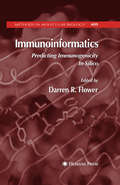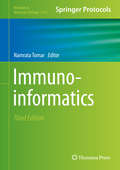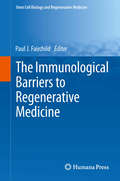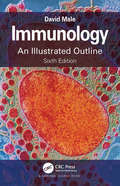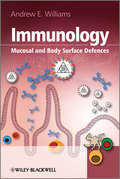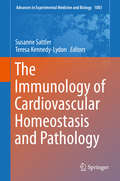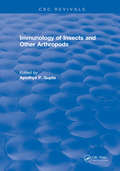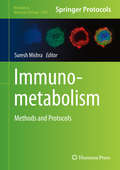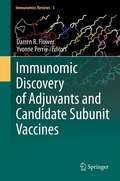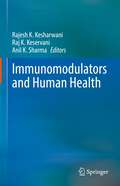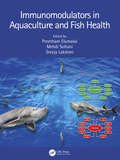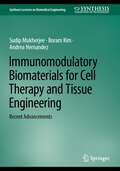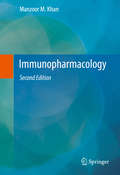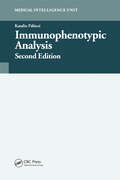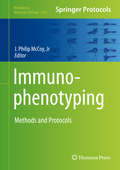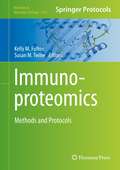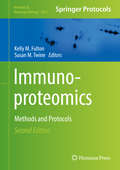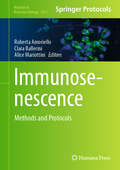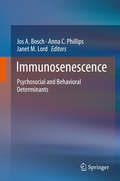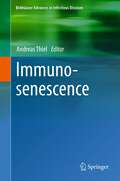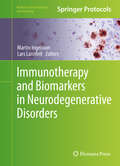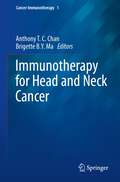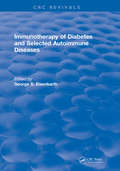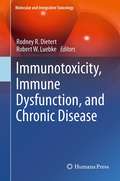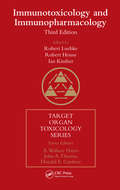- Table View
- List View
Immunoinformatics
by Darren R. FlowerThis volume both engages the reader and provides a sound foundation for the use of immunoinformatics techniques in immunology and vaccinology. It addresses databases, HLA supertypes, MCH binding, and other properties of immune systems. The book contains chapters written by leaders in the field and provides a firm background for anyone working in immunoinformatics in one easy-to-use, insightful volume.
Immunoinformatics (Methods in Molecular Biology #2131)
by Namrata TomarThis book covers a wide range of diverse immunoinformatics research topics, involving tools and databases of potential epitope prediction, HLA gene analysis, MHC characterizing, in silico vaccine design, mathematical modeling of host-pathogen interactions, and network analysis of immune system data. In that way, this fully updated volume explores the enormous value of computational tools and models in immunology research. Written for the highly successful Methods in Molecular Biology series, chapters include the kind of key insights and detailed implementation advice to encourage successful results in the lab. Authoritative and practical, Immunoinformatics, Third Edition serves as an ideal guide for scientists working at the intersection of bioinformatics, mathematical modelling, and statistics for the study of immune systems biology.
The Immunological Barriers to Regenerative Medicine
by Paul J. FairchildThis volume offers an analysis of the scale and nature of the immunological issues facing regenerative medicine, drawing on the expertise of laboratories around the world who have taken up the challenge of applying their expertise in immunology to the vagaries of stem cell biology. In Part I, we explore the extent to which the principles of allograft rejection, learned over several decades from our experiences of whole organ transplantation, apply within the unique context of cell replacement therapy. Part II discusses various innovative ways of addressing the issues of immunogenicity, while, in Part III, we focus exclusively on the induction of immunological tolerance through a variety of novel approaches. It is our hope that this systematic analysis of the current state of the field will galvanise efforts to solve an issue which has so far remained intractable.
Immunology: An Illustrated Outline
by David MaleImmunology: An Illustrated Outline is both a guide to the essential principles of immunology and a concise dictionary of immunological terms. The book can be used to consolidate understanding in preparation for course exams and medical licensing exams, or as a refresher when immunology is encountered in related life sciences, such as microbiology, virology, and zoology. The book is organized into five sections that represent the major topics in basic and clinical immunology. The Sixth Edition has been comprehensively revised to highlight the latest understanding of the field, particularly in the areas of innate immune defenses and antibody-based therapeutics. Concise explanations of immunological terms Full-color illustrations and micrographs to reinforce the text Each topic is set out in single- or double-page spreads Tables collate and summarize detailed information
Immunology: Mucosal and Body Surface Defences
by Andrew E. Williams2012 PROSE Award, Clinical Medicine: Honorable MentionThe vast majority of medically important pathogens infect their host across a body surface such as the skin, or across a mucosal tissue such as the respiratory tract or intestines, as these sites are the ones exposed to the external environment. By focusing on immunity at mucosal and body surfaces this book presents a fresh, new approach to the teaching of immunology. After an introduction to the basic structure of the immune system, the book looks at two important families of signalling molecules: cytokines and chemokines, before covering the workings of the mucosal immune system. It continues by examining immunity against the four major groups of pathogens - viruses, bacteria, fungi and parasites, and concludes by looking at disorders of the immune system, mucosal tumour immunology and the process of vaccination. A fresh, new approach to the subject focusing on mucosal and body surfaces. Describes the mucosal immune systems of the gastrointestinal, respiratory and urogenital tracts, as well as the skin. Details the important roles of cytokines and chemokines in an immune response. Separate chapters devoted to immunity against viruses, bacteria, fungi and parasites. Includes chapter summaries, boxes with topics of special interest and an extensive glossary. Clearly written and well- illustrated in full colour throughout. Students across a range of disciplines, including biology, biochemistry, biomedicine, medicine and veterinary sciences, will find this book invaluable, both as an introduction to basic immunology and as a guide to mucosal immune defence mechanisms.
The Immunology of Cardiovascular Homeostasis and Pathology
by Susanne Sattler Teresa Kennedy-LydonCardiovascular immunology is a newly emerging research area, investigating the crosstalk between the cardiovascular and the immune system. This crosstalk is evident through (1) crucial immunological capacities and functions of cardiovascular cell types, including cardiomyocytes, fibroblasts, endothelial cells, pericytes and cardiac resident macrophages, (2) the impact of aberrant immune function on the development of cardiovascular disease such as atherosclerosis, direct and indirect immune-mediated heart disease and vasculitis, and (3) the crucial role of the immune system in cardiac repair and regeneration. The Immunology of Cardiovascular Homeostasis and Pathology covers all these aspects of cardiovascular immunology, starting with homeostatic immunological functions of traditional cardiovascular cell types, and moving then to the role of the immune system in cardiovascular pathology and to recent research into targeting the immune system to boost cardiac healing and regeneration.
Immunology of Insects and Other Arthropods
by Ayodhya P. GuptaIn insect and other arthropod immune systems, discrimination between self and nonself tissues is accomplished through the combined actions of two immunocytes and several humoral factors. Immunology of Insects and Other Arthropods presents a comprehensive look at this and other important topics in arthropod immunology. Issues discussed include insect immunocytes and other hemocytes, including computer image analysis of immunocyte serial sections; the two basic cellular immune reactions (phagocytosis and encapsulation), including the molecular basis and roles of gap junctions in encapsulation; how encapsulation is affected by polydnavirus and encapsulation-promoting factors; why insect cells are immune to HIV; humoral factors; and antibacterial factors in Lepidoptera, Diptera, and other insect orders. Other topics include hemolymph proteins interacting with mammalian complement cascade; adaptive humoral response in the American cockroach; antigenic stimulation of hemaglutinin production in insects; and the applications of the Limulus Amebocyte Lysate (LAL) in detecting endotoxins in pharmaceuticals, medical devices, clinical diagnosis, and hygienic control. This book represents an important reference source for hematologists, pathologists, immunologists, AIDS researchers, comparative immunologists, and pharmaceutical companies.
Immunometabolism: Methods and Protocols (Methods in Molecular Biology #2184)
by Suresh MishraThis detailed book showcases the tremendous effort and progress made in developing techniques and protocols for the study of immunometabolism, and in utilizing recent technological advances for probing and manipulating adipose and immune cells, and subsequently, their functions and immunometabolic consequences. Written by experts in the field, many chapters use macrophages as a model immune cell type, due to their prominence in the innate immune system and the exhaustive study of their traits. Protocols using adipocytes, dendritic cells, and T cells as model cell lines, as well as measurement of glucose metabolism at the systemic level, have also been included. Written for the highly successful Methods in Molecular Biology book series, chapters include introductions to their respective topics, lists of the necessary materials and reagents, step-by-step, readily reproducible protocols, and tips on troubleshooting and avoiding known pitfalls. Authoritative and practical, Immunometabolism: Methods and Protocols serves as a vital guide for researchers working at the important interface of immunology and metabolism.
Immunomic Discovery of Adjuvants and Candidate Subunit Vaccines
by Yvonne Perrie Darren R. FlowerThis volume will address an important emergent area within the field of immunomics: the discovery of antigens and adjuvants within the context of reverse vaccinology. Conventional approaches to vaccine design and development requires pathogens to be cultivated in the laboratory and the immunogenic molecules within them to be identifiable. Conventional vaccinology is no longer universally successful, particularly for recalcitrant pathogens. By using genomic information we can study vaccine development in silico: 'reverse vaccinology', can identify candidate subunits vaccines by identifying antigenic proteins and by using equally rational approaches to identify novel immune response-enhancing adjuvants.
Immunomodulators and Human Health
by Rajesh K. Kesharwani Raj K. Keservani Anil K. SharmaThis book focuses on a broad range of immunomodulators, including both natural and synthetic ones. It highlights their role in human health. The book discusses nanotechnology-based immunomodulators with special emphasis on different types of formulation to boost the immune system. It highlights the role of immunomodulators against different microbes. This book describes important topics such as Classification and uses of various immunomodulators; Potential role of herbs and spices on immune system; Immune booster activity of prebiotics; Recent advances of nutraceutical and functional foods in Immune health; Antioxidants and immunomodulation; Nanotechnology and immunomodulators in cancer; Immunomodulatory role for the treatment and management of tuberculosis; Immunomodulation in autoimmune disorders; Herbal immunomodulators and COVID-19; Role of Cytokines as Immunomodulators and Immunomodulatory effects of endocrine disrupting chemicals. This book covers various aspects of product innovation, development, and launching of nutritional and pharmaceutical products with reference to immunomodulators. This book is meant for researchers and students in the field of immunology and pharmaceutical sciences.
Immunomodulators in Aquaculture and Fish Health
by Preetham Elumalai Mehdi Soltani Sreeja LakshmiThis reference book provides updated information about different immunomodulators for managing fish health and sustainable aquaculture. Immunomodulators are dietary additives that enhance innate defense mechanisms and increase resistance against specific pathogens and diseases. The book covers the different types of immunostimulants, their modes of action, and their efficacies. It also reviews safety concerns, ethical regulations, limitations, and outreach to farmers. It discusses the application of herbal immunomodulators, antioxidants, pre- and pro-biotics, in disease management. Features:• Reviews the pressing topic of reduction of antibiotic use in aquaculture • Discusses herbal immunomodulators, nutrients, antioxidants and pre- and pro-biotics • Covers the topic of progressive immunomodulation using nanotechnology • Discusses fish health management in the ever-growing aquaculture industry • Includes natural and synthetic immunomodulators The book is meant for researchers and industry experts in aquaculture, fisheries science, and veterinary medicine.
Immunomodulatory Biomaterials for Cell Therapy and Tissue Engineering: Recent Advancements (Synthesis Lectures on Biomedical Engineering)
by Sudip Mukherjee Boram Kim Andrea HernandezThis book presents the recent developments in immunomodulatory biomaterials for cell-based therapies in various diseases, including diabetes, cancer, cardiovascular disease, and bone regeneration. The authors first cover the fundamentals of conventional immunology and immunomodulation, before focusing on the history, advantages, and challenges of cell therapies. Biological cell therapy has gained immense attention for various diseases due to unique advantages it has over chemical drugs regarding cost, ease of production, toxicity, and therapeutic efficacy. However, these cell-based therapies need an inert delivery system that can locally deliver cells and minimally elicit foreign body response. The book discusses the foreign body response to the immunomodulatory biomaterials as well as the current and future strategies for potential mitigation of considerable immune responses toward immunomodulatory biomaterials and devices.
Immunopharmacology
by Manzoor M. KhanDuring the past decades, with the introduction of the recombinant DNA, hybridoma and transgenic technologies there has been an exponential evolution in understanding the pathogenesis, diagnosis and treatment of a large number of human diseases. The technologies are evident with the development of cytokines and monoclonal antibodies as therapeutic agents and the techniques used in gene therapy. Immunopharmacology is that area of biomedical sciences where immunology, pharmacology and pathology overlap. It concerns the pharmacological approach to the immune response in physiological as well as pathological events. This goals and objectives of this textbook are to emphasize the developments in immunology and pharmacology as they relate to the modulation of immune response. The information includes the pharmacology of cytokines, monoclonal antibodies, mechanism of action of immune-suppressive agents and their relevance in tissue transplantation, therapeutic strategies for the treatment of AIDS and the techniques employed in gene therapy. The book is intended for health care professional students and graduate students in pharmacology and immunology.
Immunophenotypic Analysis
by Katalin PálócziThis book incorporates new information regarding normal immune cell development as well as diagnosis of acute leukemias, malignant lymphomas and characterization of stem cells for transplantation. It also discusses the clinical application of immunophenotyping in immunodeficiencies.
Immunophenotyping: Methods and Protocols (Methods in Molecular Biology #2032)
by J. Philip McCoyThis volume presents the latest collection of immunophenotypic techniques and applications used in research and clinical settings. Chapters in this book cover topics such as constructions of high dimensions fluorescence and mass cytometry panels; fluorescence barcoding; using dried or lyophilized reagents; and immunophenotypic examples of specific cell types. The book concludes with a discussion on the critical roles of quality control and immunophenotyping in the clinical environment. Written in the highly successful Methods in Molecular Biology series format, chapters include introductions to their respective topics, lists of the necessary materials and reagents, step-by-step, readily reproducible laboratory protocols, and tips on troubleshooting and avoiding known pitfalls.Cutting-edge and comprehensive, Immunophenotyping: Methods and Protocols is a valuable resource for any researchers, clinician, or scientist interested in learning more about this evolving field.
Immunoproteomics: Methods and Protocols
by Kelly M. Fulton Susan M. TwineProviding current diverse approaches and techniques used to study the immunoproteome, Immunoproteomics: Methods and Protocols collects chapters from key researchers that deliver information to be used in diagnostics, disease progression, and vaccine correlates of protection analysis, to name but a few. This detailed volume includes techniques used for the study of the antibody targets of bacterial pathogens, viruses, and cancer, mass spectrometry-based approaches to characterize T-cell epitopes, chapters on detection and relative quantification of cytokines in serum, as well as in silico prediction of epitopes using sequence-based or modeling approaches. Written in the highly successful Methods in Molecular Biology series format, chapters include introductions to their respective topics, lists of the necessary materials and reagents, step-by-step, readily reproducible laboratory protocols, and tips on troubleshooting and avoiding known pitfalls. Practical and thorough, Immunoproteomics: Methods and Protocols aids researchers in transferring these techniques to their own laboratories in addition to providing a reference to guide researchers toward appropriate techniques.
Immunoproteomics: Methods and Protocols (Methods in Molecular Biology #2024)
by Kelly M. Fulton Susan M. TwineThis second edition volume expands on the previous edition with new sections describing the characterization of peptides bound to major histocompatibility complexes (MHC) on the surface of the cell. Chapters also cover topics such as using SERPA for antigen identification; antigen content of electroimmunoprecipitates; whole genome-phage display libraries; antigens in immune complexes; and immunoproteomic biomarkers. Written in the highly successful Methods in Molecular Biology series format, chapters include introductions to their respective topics, lists of the necessary materials and reagents, step-by-step, readily reproducible laboratory protocols, and tips on troubleshooting and avoiding known pitfalls. Cutting-edge and thorough, Immunoprotemics: Methods and Protocols, Second Edition is a valuable resource that presents novice and expert researchers with techniques that are easily transferrable to laboratories and provides enhanced hands-on insights into this evolving field.
Immunosenescence: Methods and Protocols (Methods in Molecular Biology #2857)
by Roberta Amoriello Clara Ballerini Alice MariottiniThis detailed book explores the interactions between different types of cells and immune cells, focusing on how their functionality is affected by immunosenescence. Beginning with traditional approaches, such as quantifying TRECs and measuring telomere lengths, the book continues with chapters on characterization of immune cell populations in aging, immune cell signaling, transcription factors, gene expression profiles, and the production of soluble factors such as cytokines, as well as computational approaches and more. Written for the highly successful Methods in Molecular Biology series, chapters include introductions to their respective topics, lists of the necessary materials and reagents, step-by-step and readily reproducible laboratory protocols, as well as tips on troubleshooting and avoiding known pitfalls. Authoritative and practical, Immunosenescence: Methods and Protocols serves as an ideal guide for researchers working in this vital area of immunology and cell biology.
Immunosenescence
by Jos A. Bosch Anna C. Phillips Janet M. LordImmunosenescence is a unique, multi-disciplinary approach to the understanding of immune aging. It addresses the topic from the biological, as well as the psychological, social and behavioral perspectives. It is, thus, a valuable and timely addition to the literature in this area. Contributors include experts in the field, reviewing the state of the art in research.
Immunosenescence
by Andreas ThielAs individuals age, their ability to respond to and clear pathogens and to control unwanted immune reactions declines, leading to a greater incidence of certain infectious diseases, autoimmunity and general immune dysfunctions. Most remarkably, the efficacy of vaccines is frequently decreased in elderly persons. Therefore, age-associated dysfunctions of the humoral and cellular immune responses have a strong clinical impact. Improving our understanding of the aged immune system is crucial in developing effective prevention and treatment programs that will facilitate healthy aging and improve the quality of life of the elderly population. The aim of this volume is to summarize current knowledge on the cellular and molecular aspects of the aging immune system, with an emphasis on infectious diseases and new therapeutic approaches.
Immunotherapy and Biomarkers in Neurodegenerative Disorders
by Martin Ingelsson Lars LannfeltThis practical volume examines a number of topicsthat explore the current status of immunotherapy and diagnostic markers forneurodegenerative disorders. With a focus on Alzheimer's disease, the firstsections of the book examine immunotherapeutic approaches for theaforementioned disease as well as for Parkinson's disease and Huntington's disease,amongst others. The last section of the book covers the importance of biomarkertechniques to catch these diseases early enough for the treatments to be mostuseful. Written for the Methods inPharmacology and Toxicology series, this book contains the kind of detaileddescriptions and implementation advice that will offer a smooth transition intothe lab. Authoritative and useful, Immunotherapy and Biomarkers inNeurodegenerative Disorders aims to aid in the continued progress in thedevelopment of novel immune-based drugs and diagnostic tools for thesedevastating brain diseases.
Immunotherapy for Head and Neck Cancer (Cancer Immunotherapy #1)
by Anthony T. C. Chan Brigette B. Y. MaThis book is a comprehensive summary of the literature on the scientific rationale and clinical development of immunotherapy for head and neck cancers.Head and neck cancer is a biologically diverse group of cancers that bear a common hallmark - evasion of host immune surveillance through innate or acquired mechanisms. The etiological association between the Human Papilloma virus (HPV) and some squamous head and neck cancers, the Epstein-Barr virus (EBV) and nasopharyngeal cancer has provided further impetus for evaluating immunotherapy in this group of cancers. The successful development of anti-programmed cell death protein-1 (PD-1)/ ligand (PD-L1) and CTLA-4 antibodies in solid tumours has gradually brought immunotherapy into mainstream oncological practice in recent years. Besides immune-checkpoint proteins inhibitors, other forms of immunotherapy such as vaccines, EBV or HPV-targeting therapies and cellular therapies are actively being investigated in clinical trials, either alone or in combination with other conventional treatments such as radiotherapy, chemotherapy and surgery. In clinical setting, the practicing oncologist need to be familiar with some unusual patterns of immunological response such as pseudo-progression and hyper-progression in patients with head and neck cancers who are undergoing treatment with immune-checkpoint inhibitors. Furthermore, the unique side effects of immune-checkpoint inhibitors such as autoimmune toxicities need to be recognized early and treated expediently. The development of biomarkers in predicting response to immune-checkpoint inhibitors has played pivotal roles in selecting patients for immunotherapy in practice or as an enrichment strategy in clinical trials. There are now emerging data on the clinical utility of biomarkers such as PD-L1 expression (Combined Positive Score), gene signatures and tumor mutational burden. This book is an invaluable companion to all those who are involved in research and clinical management of patients with head and neck cancers from any endemic regions.
Immunotherapy of Diabetes and Selected Autoimmune Diseases: Autoimmune 8
by George S. EisenbarthThis important text will be the first devoted to a detailed analysis of immunotherapy as it applies to Type I diabetes and the pathogenesis and therapy of other specific autoimmune diseases (including uveitis, multiple sclerosis, myasthenia gravis, Cogan's syndrome, Graves' ophthalmopathy, and gonadal disorders).
Immunotoxicity, Immune Dysfunction, and Chronic Disease
by Robert W. Luebke Rodney R. DietertChronic diseases are the leading cause of deaths worldwide and according to the World Economics Council and the Harvard School of Public Health, the cost of chronic diseases is expected to reach a staggering 48% of global gross domestic product by the year 2030. The urgency of the issue was demonstrated in 2011 when for only the second time in its existence, the U.N. General Assembly brought a health issue to the floor for consideration: chronic diseases. To date, most considerations of the issue have approached the topic from the vantage point that chronic diseases are a myriad of largely unconnected diseases and conditions arising in diverse tissues, organs and physiological systems. This book, Immunotoxicity, Immune Dysfuction, and Chronic Disease, deviates from that prior model. It considers the interconnectivity of chronic diseases with both environmental insult of the immune system and subsequent immune dysfunction and inflammatory dysregulation as the underlying basis for many, if not most, chronic diseases. This change in the perception of environment-immune linkages to chronic disease is significant and has immediate implications both for the prevention of disease as well as for the development of more effective therapeutic approaches. Rather than considering environmental factors and types of reported immune alterations (e.g., depressed humoral immunity) as is common in books involving immunotoxicity, the present book approaches the environment-immune-disease triad from the standpoint of the disease. Each chapter emphasizes one or more specific immune dysfunction-based chronic disease(s) or condition(s) (e.g., asthma, atherosclerosis, multiple sclerosis, lupus) and describes: 1) the suggested environmental risk factors, 2) the underlying immune dysfunction(s) associated with the disease and 3) the overall health consequences of the disease. This book is an early entry for a new Toxicology book series for Springer titled: Molecular and Integrative Toxicology (MaIT). The series will feature detailed research information, but in the context of a more integrative or holistic framework. As part of this framework, the chapters will contain a section on "Key Points" as well as "Recommendations" where appropriate. The goal is to cover the most timely, state-of-the-art issues in toxicology as well as to ensure that the information is maximally accessible for research scientists, teachers, physicians and students. We are particularly grateful to the numerous chapter authors for providing comprehensive and expert disease-oriented contributions. We are also appreciative of their willingness to consider their material not as disparate pieces of what has become a major health crisis, but rather as key pieces in a network of apparently interconnected health challenges.
Immunotoxicology and Immunopharmacology
by Robert Luebke Robert House Ian KimberContinuing the tradition set by the first and second editions, each a bestseller in its own right, the third edition of Immunotoxicology and Immunopharmacology provides reviews of environmental agents, updated to reflect the latest information on how these agents influence immune system function and health. For the first time in the book's history,
